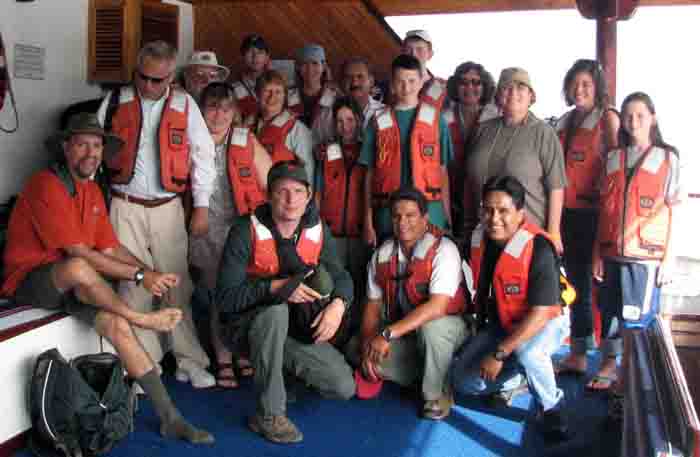Home | Tours | Trip Reports | News | Team | Calendar | Links | Contact | Store | Mailing List
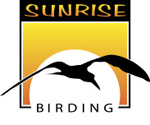 Galápagos Trip Report
Galápagos Trip ReportJune 29 - July 11, 2008
SPECIES LIST>(word) REPORT>(word)
LEADERS: Luke Tiller & Juan Carlos Calvachi
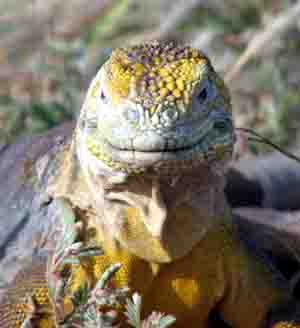
Sun. June 29th – Arrival in Quito Ecuador
Sunday was arrival day for most people at El Jardin, our base whilst in Ecuador. The majority of the group had arrived a few days beforehand and had already been making the most of all that Quito has to offer with birding, shopping, culture and other activities. Whilst I recovered from my jetlag and waited for people to arrive at El Jardin the Cunniffe's headed out for some zip-lining in the Mindo Cloud Forest.
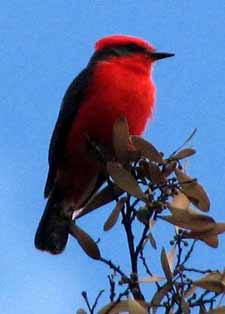 There are plenty of avian delights to enjoy in the bucolic surroundings of Juan’s yard as well as horses, chickens and amazing views of the surrounding mountains. The Mains and the Heaphys arrived early afternoon and I gave them an impromptu introduction to the birds of Ecuador as viewed from Juan’s yard. We had a fun afternoon ticking off some common species such as Great Thrush, Saffron Finch, Rufous-collared Sparrow as well as a number of hummingbirds: the ludicrously tailed Black-tailed Trainbearer, the ubiquitous Sparkling Violetear, as well as Western Emerald and White-bellied Woodstar. There was also the familiar in the shape of a pair of exquisite Vermillion Flycatchers and an American Kestrel.
There are plenty of avian delights to enjoy in the bucolic surroundings of Juan’s yard as well as horses, chickens and amazing views of the surrounding mountains. The Mains and the Heaphys arrived early afternoon and I gave them an impromptu introduction to the birds of Ecuador as viewed from Juan’s yard. We had a fun afternoon ticking off some common species such as Great Thrush, Saffron Finch, Rufous-collared Sparrow as well as a number of hummingbirds: the ludicrously tailed Black-tailed Trainbearer, the ubiquitous Sparkling Violetear, as well as Western Emerald and White-bellied Woodstar. There was also the familiar in the shape of a pair of exquisite Vermillion Flycatchers and an American Kestrel.
Over the rest of the day and into the evening the rest of the group drifted in until we sat down for our first group meal together and our introduction to the fabulous world of Ecuadorian soups which were to rapidly become a highlight of the holiday.
Mon. June 30th – Day Trip to the Andes
We started the day working our way up towards the famous hot springs up at the Papallacta Pass. Our first stop up the pass we pulled onto a side road and started our search for the much sought after Andean Condor. The scenery was amazing with huge rocky cliffs, deep ravines, tumbling waterfalls that dropped hundreds of feet and lush green pastures reaching up into the valleys. No Andean Condor was to be found but we quickly locked onto the magnificent sight of 20 or so Carunculated Caracaras soaring majestically above the astounding backdrop of the Andean cliffs surrounding us. Other birds started to show themselves: a Giant Hummingbird perched along a nearby power line - how does this thing hover - it's almost the size of a small dog!!!!!!! Tufted Tit-Tyrant, Azara's Spinetail, Plain-colored Seedeater and probably the highlight of the stop a pair of Red-crested Cotingas, simply magnificent!
Next a stop were the famous springs at Papallacta (via a quick pullover that gave us astounding looks at more Carunculated Caracaras and Andean Gulls picking over a freshly tilled field). Although the waters at the springs looked very appealing some of the group decided that although it was misty and drizzling that we would go do a little birding along the road behind the baths and see what was around. Shining Sunbeams (what a beautiful hummingbird) perched up showing their unbelievable rainbow tinted backs and were a real reward in the gloom and a White-sided Flowerpiercer rounded out the 4 species that we saw on the trip. Near a beautiful and raging waterfall we added another cracking colibri (the Spanish name for hummingbird and much more enchanting in my opinion) in the shape of the monstrous Great Sapphirewing as well as Pale-naped Brush-finch. Although the weather could have been more conducive we managed to add a few more bird species to the tally and much to everyone’s entertainment we all enjoyed spending a few minutes with the Andes friendliest horses.
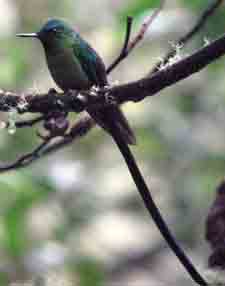 It was almost time for lunch and time to head for somewhere dryer and so we were on our way down to Guango Lodge. Guango Lodge is at lower elevation than Papallacta and we were greeted by our first encounter with what appeared at least to me proper rainforest, bromeliads in every tree, moss and lichen dripping from the branches – simply stunning. Guango itself is pretty much hummingbird heaven, a fantastic place with loads of birds buzzing everywhere, in fact almost too many to even concentrate on any one particular bird and a real avian treat even for the less ardent birders on the trip. The first one we spotted on entrance was a Chestnut-breasted Coronet, a stunningly beautiful hummer, but we hardly had time to appreciate it as the winged delights just kept coming thick and fast. My dream hummer, the Collared Inca put in an appearance followed by Tourmaline Sunangels, Buff-winged Starfrontlets, clouds of cheery little White-bellied Woodstars, the simply outrageous Long-tailed Sylph and the preposterous Sword-billed Hummingbird (how that bird doesn't constantly bang into things was the big question of the day). Daniel and I got a good view of how the Sword-billed uses that bill to keep other birds from the feeders as it jabbed a nearby Inca off of a branch! All in all there were hundreds of hummers all vying for the 10 or 15 feeders set up around the garden at any one time and it was almost impossible to decide where to look next
It was almost time for lunch and time to head for somewhere dryer and so we were on our way down to Guango Lodge. Guango Lodge is at lower elevation than Papallacta and we were greeted by our first encounter with what appeared at least to me proper rainforest, bromeliads in every tree, moss and lichen dripping from the branches – simply stunning. Guango itself is pretty much hummingbird heaven, a fantastic place with loads of birds buzzing everywhere, in fact almost too many to even concentrate on any one particular bird and a real avian treat even for the less ardent birders on the trip. The first one we spotted on entrance was a Chestnut-breasted Coronet, a stunningly beautiful hummer, but we hardly had time to appreciate it as the winged delights just kept coming thick and fast. My dream hummer, the Collared Inca put in an appearance followed by Tourmaline Sunangels, Buff-winged Starfrontlets, clouds of cheery little White-bellied Woodstars, the simply outrageous Long-tailed Sylph and the preposterous Sword-billed Hummingbird (how that bird doesn't constantly bang into things was the big question of the day). Daniel and I got a good view of how the Sword-billed uses that bill to keep other birds from the feeders as it jabbed a nearby Inca off of a branch! All in all there were hundreds of hummers all vying for the 10 or 15 feeders set up around the garden at any one time and it was almost impossible to decide where to look next
It was hard to drag ourselves away from the constant action at the feeders but after adding a another couple of species including a subtle but rather beautiful Speckled Hummingbird and the somewhat less common Golden-breasted Puffleg some of the group decided to have a little hike of the grounds along the river behind the Lodge. Birding heaven is all I can describe as the moment that you hit your first flock of passerines in the tropics; it has all the raw excitement of hitting a wave of warblers in migration in the States but with more variety of birds. We managed to pull out Spectacled Whitestart, Cinnamon Flycatcher, the rather wonderfully named Superciliaried Hemispingus as well as a rather nice Gray-hooded Bush-tanager. These mixed flocks disappear as quickly as they appear though, and just like that the raucous flock was gone, leaving hearts racing and a couple of mysterious unidentified flying objects spinning around in our heads. The river walk was capped off with a rather nice Andean Guan perched unassumingly in a tree across the road in some dense vegetation.
As a special treat at the end of our lodge visit Alex, who fills the feeders at the lodge, lead us to a small stone slab placed in a gap amongst some dense shrubbery near the gated entrance of the lodge. Here he started to whistle in a Chestnut-crowned Antpitta and showered with offerings of worms the bird appeared just like that. What a moment and a great finale to our visit. I think many of us could have just stayed with that elusive and very special bird all day, but by now it was time to return for dinner so reluctantly we said goodbye to Guango. On the way home a forlorn scan of the skies in the hopes of adding Andean Condor did at least allow Annette to pull a majestic Black-chested Buzzard Eagle out of the mist allowing the group distant but diagnostic views of this raptor, adding to our earlier sighting of a dark morph Variable Hawk. We also encountered a rainbow on the way home; with its misty mornings and sunny afternoons, at this time of year it seems like Ecuador is the land of rainbows.
Over the evening dinner the group was all abuzz with the wonderful hummingbird experiences from Guango and all picked this as there favorite part of the day, apart from our resident scientist Andy who (semi-jokingly – I think!) was much taken by the road kill lizard that we had discovered at one of our early stops. Different strokes for different folks as they say!
Tues. July 1st – Travel to the Galápagos Islands
We were up and out early refreshed by another big breakfast at El Jardin and were on our way to the airport and our flight out towards the Galapagos. Prior to breakfast we had a few minutes of free time which was just enough to pin down a couple of the El Jardin’s avian regulars for those that hadn’t had a chance to see them the day before, the undoubted highlight being a Southern Yellow Grosbeak.
As with everything organized by Juan, the travel portion of the day went extremely smoothly although the airport had a somewhat chaotic and relaxed feel when you have become so used to the strictly enforced rules of US Airports. A stop off a Guayaquil Airport and some sneaky window seat birding whilst awaiting new passengers allowed us to add Tropical Kingbird, Gray-breasted Martin and Cattle Egret to our ever-expanding trip list.
 We arrived at Baltra airport late afternoon and within minutes the Galapagos fun started. Whilst awaiting the bus to the ferry Andy and Daniel managed to spot a rather large and fairly laid back Land Iguana which posed nicely for pictures whilst David used his Spanish expertise to help make sure we were getting on the right bus for the ferry terminal whilst Juan went ahead with our bags!
We arrived at Baltra airport late afternoon and within minutes the Galapagos fun started. Whilst awaiting the bus to the ferry Andy and Daniel managed to spot a rather large and fairly laid back Land Iguana which posed nicely for pictures whilst David used his Spanish expertise to help make sure we were getting on the right bus for the ferry terminal whilst Juan went ahead with our bags!
After a short drive we arrived at our first marine experience of the trip, the short ferry hop across to Santa Cruz Island. It may have only been a few hundred meters but in that time we had all managed to add a few nice pictures and a few new trip birds to the list. Brown Noddies flitted around the boat (like a negative of your average tern the Noddy switches your usual white tern with a dark cap round into being a dark bird with a white cap); majestic and colorful Brown Pelicans lounged in the Mangroves, Blue-footed Boobies plunge-dived alongside the boat and our first Galapagos Shearwater scurried by. After a cross island bus journey (dodging suicidal but as yet unidentified Darwin’s Finches) we arrived in Puerto Ayora to our inviting hotel.
Before our first island dinner we just had enough time to take a wander down to the Puerto Ayora Fish Market and one of the manmade highlights of these beautiful islands. The freshly caught fish bring in all kinds of wildlife hoping to grab a tasty morsel from the scraps. These included Magnificent Frigatebirds, our first Lava Gull as well as a group of rather ornery Brown Pelicans. Surrounding the market are some jet black lava rocks which gave us our first encounter with hundreds and hundreds of Sally Light Foot Crabs and the attached mangroves provided cover for a number of new bird species including Lava and Striated Herons (now considered the same species), Yellow-crowned Night-heron and Mangrove Warblers.
Stealing the show (and most of the fish) at the Santa Cruz Fish Market however were the exceedingly tame Galapagos Sea Lions which posed graciously for photos until one German tourist tried to impinge just a little too much on one of the sea lions personal space and came close to finding out just how hard one of those lions can bite, a reminder that these are wild animals that one is dealing with however accommodating and cute they might have appeared. Exploring Puerto Ayora many of the group found themselves inextricably drawn to a quiet little beer stand on one of the side alleys and we spent a pleasant half an hour or so soaking up the atmosphere of the town and its beautiful harbor and surrounding cool blue seas with a cold beer and some great ceviche.
That evening we were off to Café Hernan for food and celebrated our arrival on the islands and David and Stephanie's wedding anniversary over the meal. I had planned to mark the occasion with a bottle of vintage Cristal but unfortunately Champagne selection on the island was not what it might have been and we ended up with the not quite as flash but equally as quaffable Chilean version, a nice evening and a relaxing way to round out our first day on the Islands.
Wed. July 2nd – Day Exploring Santa Cruz
Today was our first real day to explore the islands and start to look for some of the endemic birds that make up the highlights of any trip to the Galapagos. Our first stop was just off of the main cross island highway and within the agricultural zone of Santa Cruz. This was our best chance of finding some of the finches that call the Santa Cruz home and also a good spot to look for the elusive Paint-billed Crake. What I think most impressed most of the group was the amazingly abundant vegetation on the island. I think that the dusty and dry airport at Baltra was the kind of landscape many of us had been expecting but here we were greeted by lush greenery.
Our first stop was at the edge of an agricultural plantation which was covered with wildly exotic fruits such as papaya and plantain. Juan Carlos our trusty tour organizer and bird guide quickly located some of the harder to find finches including Small and Large Tree Finch, a jaunty upside down Woodpecker Finch and a rather showy Vegetarian Finch which had the good grace to put on a show for us atop a nearby telephone pole. We also spotted a Large Ground Finch and Juan's keen eyes pulled out a surprisingly difficult to spot Purple Gallinule perched up on a small palm. No Paint-billed Crake today but we had another shot later in the week so we called it a day and made a beeline for our next quarry the Galapagos Rail.
The Galapagos Rail is obviously a close relative of the tiny Black Rail, possibly one of North America's most sought after bird species. Like the Black Rail the Galapagos Rail is a notorious skulker and its home amongst the dense shrubbery of the damp uplands in Media Luna makes the bird impossible to see without some auditory assistance, and even with it there are no guarantees. After a few unsuccessful attempts to lure out one of these little gems we reached an area where a rail was calling without any prompts from Juan Carlos's iPod. The group gathered and Juan gave the bird a few quick blasts from the iPod and soon we had our response as first one and then a second bird started to call from deep within a nearby shrubbery. Using a laser pen Juan pointed the group to near where the Rails were and through the small windows in the dense foliage most of the group got great up-close looks at the birds as they scurried along the floor of the underbrush.
Some of the group had missed the bird however, but the birding gods were with us that day and as we descended back towards the bus the rails decided to follow us and find out exactly what that other Galapagos Rail was doing in Juan's pocket. Their continued calling kept my attention and I noticed that we were arriving at a nice gap in the constant shrubby cover. I asked Juan to give the rails one last blast of the iPod and the handful of participants who had not managed good views of the birds crowded around the opening and this time the birds popped right out on some rocks leaving everyone more than satisfied with their views of this striking little bird.
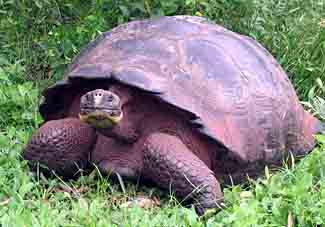 Our next portion of a trip required a short hop in the bus as we headed out for our first encounter with one of the stars of Santa Cruz, the islands Giant Tortoises. It really was like something out of Jurassic Park as we turned a corner to see this behemoth standing under a small tree taking a well earned break from the sun. Whilst pictures were taken with some of these magnificent creatures we also managed to spot a couple of Dark-billed Cuckoos, a rather striking member of the Cuckoo family and almost as tough to spot as their North American cousins. On a nearby pond we also discovered two perched Galapagos Pintail posing perfectly for photographic opportunities. The kids managed to get some rather nice footage of the lumbering giants as we discovered more and more of the tortoises just ambling around the nearby fields.
Our next portion of a trip required a short hop in the bus as we headed out for our first encounter with one of the stars of Santa Cruz, the islands Giant Tortoises. It really was like something out of Jurassic Park as we turned a corner to see this behemoth standing under a small tree taking a well earned break from the sun. Whilst pictures were taken with some of these magnificent creatures we also managed to spot a couple of Dark-billed Cuckoos, a rather striking member of the Cuckoo family and almost as tough to spot as their North American cousins. On a nearby pond we also discovered two perched Galapagos Pintail posing perfectly for photographic opportunities. The kids managed to get some rather nice footage of the lumbering giants as we discovered more and more of the tortoises just ambling around the nearby fields.
On the little post lunch walk we took we discovered loads and loads of papaya and passion fruit trees lining the trail and we picked up as many as we could find. Unfortunately the passion fruit seemed not to be ripe and so these were still very sour, but the smell of the fruit was intoxicating. We also managed to see a few passion 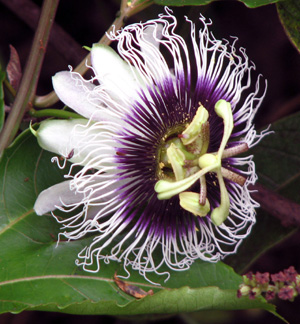 fruit flowers which were incredibly complex and beautiful somewhat akin to white and purple sea anemones. Back at the ‘tortoise farms’ restaurant we had some food and the kids posed for photos with the tortoise carapaces that were on show there on their backs, in-between hard fought games of ping pong.
fruit flowers which were incredibly complex and beautiful somewhat akin to white and purple sea anemones. Back at the ‘tortoise farms’ restaurant we had some food and the kids posed for photos with the tortoise carapaces that were on show there on their backs, in-between hard fought games of ping pong.
After the visit to the ‘tortoise farm’ we went on for an exploration of the islands Lava Tubes. These tubes have formed underground caverns over a half mile long and were fun to explore even for an admitted claustrophobe like myself. The most entertaining part of the trip was right at the very end where the tube narrowed rapidly and required everyone to scramble on their hands and knees under an rock abutment that left one with only a couple of feet of room of crawl space to get to the other side. It was quite an adventure and the plastic sheeting didn't quite meet the task of keeping you from the wet and muddy lava tube floor but a little mud wasn’t going to dampen our enthusiasm. The kids got some action shots of the group as we appeared through the other side of the abutment on hands and knees and we all did our best to ham it up a little for the cameras.
Although the local food in Ecuador was excellent, we had the treat of pizza night at Café Hernan that evening and everyone enjoyed a little slice of home (excuse the pun). After dinner Juan and I and a few of the group decided to hang on at the cafe. That evening it was the South American Soccer Club Championship and Ecuadorian side Liga were facing off against Brazilian giants Fluminense in the Maracana Stadium. It was a thrill a minute game which the Ecuadorians finally won on penalties after a thrilling 5-5 draw after extra-time. An unexpected addition to the trip and a fun evening watching the locals let their hair down. By the time we left the bar the local Galapaganians had organized a somewhat impromptu procession down Main Street with passing cars, trucks and motorbikes honking their horns, flashing their lights and every truck was bedecked with kids (and adults) waving flags. People were jumping up on passing flatbed trucks to join the celebrations and the last we saw of David that night was as he leapt aboard one of the passing pick-ups to join the celebrations and catch a crafty lift home. A really fun night out!
Thurs. July 3rd – Travel to San Cristóbal Island to meet the boat Millennium
 This morning we set off to join our boat (The Millennium) for our cruise around the islands of the Galapagos. From Santa Cruz we took a high speed boat out across to San Cristóbal Island. It was quite an adventure with some fairly rough seas and really put all of our seasickness remedies to the test and I spent much of the time regretting having a third beer the night before. Juan seemed to take it all in stride by sleeping his way through the trip laying out on our baggage whilst Mike the trips seasoned deep sea fishermen was in his element as we roared towards the next segment of the trip. During the trip we managed to occupy ourselves picking up a few new bird species for the trip including both White-vented and Wedge-Rumped Storm Petrels as well as some great looks at Galapagos Shearwater and Dark-rumped Petrels as they arced across the water behind the boat. Another highlight was the multitudes of flying fish which erupted from the water throughout the trip.
This morning we set off to join our boat (The Millennium) for our cruise around the islands of the Galapagos. From Santa Cruz we took a high speed boat out across to San Cristóbal Island. It was quite an adventure with some fairly rough seas and really put all of our seasickness remedies to the test and I spent much of the time regretting having a third beer the night before. Juan seemed to take it all in stride by sleeping his way through the trip laying out on our baggage whilst Mike the trips seasoned deep sea fishermen was in his element as we roared towards the next segment of the trip. During the trip we managed to occupy ourselves picking up a few new bird species for the trip including both White-vented and Wedge-Rumped Storm Petrels as well as some great looks at Galapagos Shearwater and Dark-rumped Petrels as they arced across the water behind the boat. Another highlight was the multitudes of flying fish which erupted from the water throughout the trip.
We arrived at our boat just in time for lunch and although a couple of the group were distinctly not in the mood for food at that moment in time we were greeted onboard with an excellent and hearty meal, a luxury we would become very used to over the next week. After a little break we took one of the zodiac boats out onto the island and headed out on a bus to the Saddleback Tortoise breeding center. By this time we were joined by Santiago our Galapagos National Parks guide. He was one of the younger guides on the islands but was a wealth of knowledge and a fountain of enthusiasm on the trip. From him we learnt all about the trials and tribulations that the park service had gone through to carefully hone their breeding programs down to a fine art. The group was amazed to discover that the scientists running the program could, through the careful manipulation of incubation temperatures, even determine the sex of the tortoises that they were going to produce.
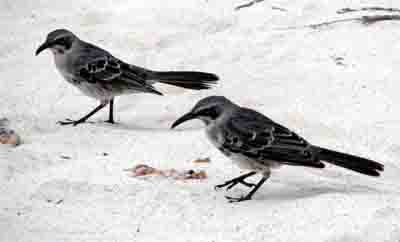 The saddlebacks have developed particularly long necks to help them feed on the local vegetation which usually comprises of little ground vegetation. However on our trip San Cristóbal was experiencing something of a wet year and was, as with many of the islands, covered in fairly luxuriant vegetation, a phenomenon that Santiago assured us only happened perhaps once or twice a decade. We then walked the trails at the center and spent some time with the free-roaming tortoises there. The saddlebacks due to their harsher existence on San Cristóbal do not gain the extreme size of the Santa Cruz Tortoises but are still a sight to behold. Whilst there we added another endemic mockingbird to our trip list the unsurprisingly named San Cristóbal Mockingbird.
After the coach picked us up we spent time shopping in town (Puerto Baquerizo Moreno). The girls on the trip rapidly became quite the bargain hunters and were soon uncovering the best of island shopping and dinner conversation was rapidly turned over to price comparisons and store highlights between the two islands.
The saddlebacks have developed particularly long necks to help them feed on the local vegetation which usually comprises of little ground vegetation. However on our trip San Cristóbal was experiencing something of a wet year and was, as with many of the islands, covered in fairly luxuriant vegetation, a phenomenon that Santiago assured us only happened perhaps once or twice a decade. We then walked the trails at the center and spent some time with the free-roaming tortoises there. The saddlebacks due to their harsher existence on San Cristóbal do not gain the extreme size of the Santa Cruz Tortoises but are still a sight to behold. Whilst there we added another endemic mockingbird to our trip list the unsurprisingly named San Cristóbal Mockingbird.
After the coach picked us up we spent time shopping in town (Puerto Baquerizo Moreno). The girls on the trip rapidly became quite the bargain hunters and were soon uncovering the best of island shopping and dinner conversation was rapidly turned over to price comparisons and store highlights between the two islands.
Fri. July 4th - Travel to Espanola Island
After traveling overnight we arrived bright and early at Espanola for our first wet landing; going over the side of the zodiacs and planting our feet on a beautiful fine white sand beach. On arrival we had great looks at our first Black-necked Stilt which almost appeared to be there to welcome us to this gorgeous island. We were also greeted by highly inquisitive flocks of Espanola Mockingbirds which were looking to pinch an easy meal or a handout of fresh water.
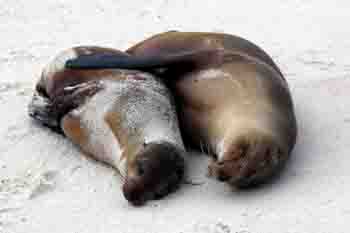 We took off on a hike along the stunning beach, making the most of the amazing photographic opportunities of nearby islands, the pristine beach and the sparkling water whilst stepping lightly around the large numbers of lounging Galapagos Sea Lions. Although the Sea Lions are generally very sedentary (and obligingly and cutely pose for photos) one does need to give these impressive animals a respectful amount of room and watch for both protective mothers and the dominant alpha males that steadfastly protect their beach from invaders.
We took off on a hike along the stunning beach, making the most of the amazing photographic opportunities of nearby islands, the pristine beach and the sparkling water whilst stepping lightly around the large numbers of lounging Galapagos Sea Lions. Although the Sea Lions are generally very sedentary (and obligingly and cutely pose for photos) one does need to give these impressive animals a respectful amount of room and watch for both protective mothers and the dominant alpha males that steadfastly protect their beach from invaders.
Whilst some of the group took some time off to relax, read or write up their diaries those that wanted to took a zodiac out to Gardner Bay for a spot of snorkeling. For many including myself this was a first taste of ocean snorkeling and we were amazed to discover that the beauty of these bounteous and well protected islands continued to be reflected beneath the waves that surround them. It was like diving into a tropical fish tank as parrotfish of many hues, dazzling damselfish and huge shoals of Black-striped Selimas put on a quite the display. Santiago, an expert diver, even had one of the more inquisitive Sea Lions come and join him for a little bit of playtime. David and Meaghan managed to encounter a distant Galapagos Shark on their way back to the beach and although quite harmless I think many of the group felt a mixture of both relief and regret on not having had that particular encounter.
During another delicious lunch we moved on to Punta Suárez for our afternoon cliff walk. Even from the Boat we had an idea of the treats that were about to greet us on the walk. Galapagos Hawks were flying up and down the slopes that lead down to the beach (one perching generously on the small lighthouse that marked the landing area). Overhead Nazca Boobies and stunningly elegant Red-billed Tropicbirds roamed the skies and over the island we could just make out some Waved Albatrosses soaring around the islands. As we made our way downstairs to the zodiacs one of these magnificent birds arced in off of the sea heading towards our afternoon destination the fabled ‘Albatross Runway’ of Espanola Island.
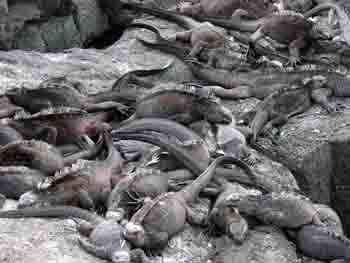 The cliffs on Espanola are truly magnificent and our hike up there was well worth it. The deep blue see crashed magnificently against the rocky coastline creating incredible foaming waves and the blowholes in the rocks fired their spouts of water many feet into the air. Once again we were met by the ubiquitous but fascinating Marine Iguanas and Lava Lizards. It was then that we got our first close up views of a pair of dark morph Galapagos Hawks. These birds were banded as part of a program to monitor hawk movements between the islands and they put on a great show perching all around us as we hiked up to 'The Runway'. At this time Santiago spotted another lava lizard appearing from a burrow. As the group stopped to look at the emerging lizard one of the eagle-eyed hawks spotted his opportunity for a good meal and swooped in, not a dozen feet from most of the group, and snatched up the lava lizard for his afternoon snack. Juan said that he’d never seen anything quite like that hawk attack on his many visits to the island and we had added another simply amazing moment to the tour, one which left most of us wishing we were a little quicker on the draw with our cameras.
The cliffs on Espanola are truly magnificent and our hike up there was well worth it. The deep blue see crashed magnificently against the rocky coastline creating incredible foaming waves and the blowholes in the rocks fired their spouts of water many feet into the air. Once again we were met by the ubiquitous but fascinating Marine Iguanas and Lava Lizards. It was then that we got our first close up views of a pair of dark morph Galapagos Hawks. These birds were banded as part of a program to monitor hawk movements between the islands and they put on a great show perching all around us as we hiked up to 'The Runway'. At this time Santiago spotted another lava lizard appearing from a burrow. As the group stopped to look at the emerging lizard one of the eagle-eyed hawks spotted his opportunity for a good meal and swooped in, not a dozen feet from most of the group, and snatched up the lava lizard for his afternoon snack. Juan said that he’d never seen anything quite like that hawk attack on his many visits to the island and we had added another simply amazing moment to the tour, one which left most of us wishing we were a little quicker on the draw with our cameras.
On the way up to the 'Runway' we encountered many of the islands other incredible fauna including Nazca and Blue-footed Boobies that were nesting almost on the trail itself. Swallow-tailed Gulls nested on the nearby cliff faces, surely one of the planets most beautiful larid species, more Tropicbirds zoomed nosily overhead like a squadrons of jet-fighters and in one of the rock pools we spotted our first Wandering Tattler, a treat for the shorebird aficionados amongst us.
Then it was on for our David Attenborough moment up at the 'Albatross Runway'. It was amazing to finally be in the presence of birds that are the highlight of so many nature programs. There were Waved Albatross everywhere and we were treated to their slightly ridiculous but enchanting courtship ritual and another few gigabytes of memory cards were filled as we happily snapped pictures and made video captures of these amazing creatures. We were also lucky enough to find a couple of newly hatched chicks being tended to. A truly memorable afternoon and one which was probably rank as one of most peoples highlights of the whole trip and certainly an afternoon that will live long in the memory of all.
Sat. July 5th – Travel Floreana
The next morning we were up bright and early and up on deck scanning a large rocky Island (Isla Champion) from the boat in hopes of seeing the rare and most localized mockingbird of the trip, the Floreana Mockingbird. With a little luck we soon had a couple of pairs that were perched up on a few of the cactus that dotted the slope that we were scanning and eventually everyone managed decent looks at the birds that although not far away were quite a challenge to get in the scope from an undulating boat. Whilst we scanned for the mockingbirds we were treated to our first view of Greater Frigatebirds. Although very similar to the Magnificent Frigatebirds, surprisingly it was the female and immature birds that were fairly readily separable in the field with their slightly different head and throat patterns.
After breakfast we set down on another beautiful sand beach. Here we were treated to Diamond Stingrays swimming in the shallows and a Galapagos Penguin patrolled the cove, only appearing intermittently as he fished up and down the beach. It was like looking for an elusive loon on any Connecticut Beach in winter, no sooner had we got him in the scope then down he would go disappearing below the waves. After a short hike inland we came upon our first Greater Flamingos. Another avian treasure so beloved of nature documentaries and here we were standing just a few feet from one of them. Amongst the Flamingos we also managed to see some Galapagos Pintail (for just the second time on the trip) and Santiago pointed out a rocky nesting area for the Flamingo's which seemed to be a hubbub of activity. Before we set off for lunch there was time for more snorkeling to be enjoyed and we were again joined on our swim by an inquisitive Seal Lion that decided to join us on our snorkeling adventure into a beautiful water filled cave.
After lunch we were on a quest for the last missing finch that we could see on our trip and about to learn something about the somewhat bizarre history of Floreana Island. We set off for the islands highlands with Juan’s trusty iPod in hand ready to try and call in the somewhat difficult to locate Medium Tree Finch a bird that exists solely on Floreana. It took a little coaxing but eventually the entire group got great looks at this extremely localized endemic species as we tracked it down in some woodland surrounding a small agricultural plantation.
Floreana has a small population of inhabitants and after tracking down the tree finch we were treated to a history of the human presence on Floreana by Santiago. And quite a history it is. Apparently the first resident of the islands was an Irishman marooned here for two years in 1807. However the most intriguing story is that of those inhabitants that arrived in the interwar years. A German couple, Friedrich Ritter and Dore Strauch arrived on Floreana in the 1920's in search of paradise and a peace and tranquility that they believed couldn't be found in interwar Europe. They persuaded their respective spouses to live together, and before leaving Germany had all their teeth removed so as to negate the possibility of dental problems that they might encounter. To remedy their toothlessness they apparently had one pair of stainless steel dentures made in order to eat, which they all shared amongst themselves!
A few years later they were joined by Wittmer family and 'Baroness' von Wagner Bosquet, who arrived on the island sporting her three young lovers. A series of strange events culminating in several mysterious deaths and disappearances left Margaret Wittmer the sole survivor of the original settlers. A book written about these events is called "The Devil Came to Paradise". We visited the area the Wittmers had first inhabited and got to see some of the interesting caves and carvings that the family had created around their initial island home. The remains here appeared somewhat creepy after hearing the tales of the mystery surrounding the early settlers and adding to the ethereal and spooky effect was the presence of large trees that covered the area with these beautiful yet monstrous tubular flowers. Santiago informed us that mild hallucinogenic effects could be had by sniffing the flowers, I however couldn't possibly comment on whether any of the group ventured to give this a try.
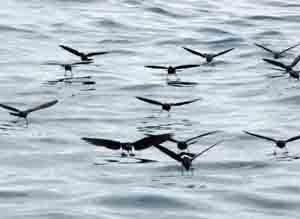 Despite the eerie atmosphere created by the stories, the mist and the flowers it really was a beautiful and scenic place and gave amazing views of the rest of the island, no wonder these early settlers had decided to set up home here. Whilst the group snapped away with our cameras we spotted a small pond down below us on the slope and with much hard work managed to find a couple of American Moorhens sat upon it. We returned to the boat on our little truck/coach with a few of us enjoying a rooftop ride back to the boat which was great fun until we hit some low hanging trees on the way back to town, if it wasn’t for a quick duck and cover maneuver by myself, Annette and Dan we might have found ourselves hanging off of one, a pretty exciting and adrenaline fueled end to the ride!
Despite the eerie atmosphere created by the stories, the mist and the flowers it really was a beautiful and scenic place and gave amazing views of the rest of the island, no wonder these early settlers had decided to set up home here. Whilst the group snapped away with our cameras we spotted a small pond down below us on the slope and with much hard work managed to find a couple of American Moorhens sat upon it. We returned to the boat on our little truck/coach with a few of us enjoying a rooftop ride back to the boat which was great fun until we hit some low hanging trees on the way back to town, if it wasn’t for a quick duck and cover maneuver by myself, Annette and Dan we might have found ourselves hanging off of one, a pretty exciting and adrenaline fueled end to the ride!
On return to the boat we were lucky enough to be joined on our departure from Floreana by a group of Common Dolphins. A swift piece of maneuvering on behalf of our boat captain soon had the pod of dolphins joining us to ride the bow of the ship, yet another delightful moment on a trip that included so many. Amongst the ubiquitous Wedge and White Vented Storm-petrels Juan’s sharp eyes managed to pick out our first and only Band-rumped Storm-petrel of the trip.
Sun. July 6th – Return to Santa Cruz
 This day we were off to the Darwin Center back on the island of Santa Cruz and an audience with perhaps The Galapagos's most well known conservation symbol, Lonesome George. Lonesome George is the last of his species, a Pinta Island Tortoise (all of the various endemic subspecies of giant tortoise have apparently been raised to species level). It was interesting to meet with George but there was of course a tinge of sadness that the islands most well known conservation icon is on his way to extinction unable to mate with the two companion females from the genetically similar grouping of tortoises from Wolf Island that share his enclosure.
This day we were off to the Darwin Center back on the island of Santa Cruz and an audience with perhaps The Galapagos's most well known conservation symbol, Lonesome George. Lonesome George is the last of his species, a Pinta Island Tortoise (all of the various endemic subspecies of giant tortoise have apparently been raised to species level). It was interesting to meet with George but there was of course a tinge of sadness that the islands most well known conservation icon is on his way to extinction unable to mate with the two companion females from the genetically similar grouping of tortoises from Wolf Island that share his enclosure.
The Darwin Center is a great place to get up close and personal with these wonderful animals. Not only is it a breeding center but it also provides home comforts for giant tortoises that were once held as pets (hard to believe), not adapted for the wild they make their homes here at the center and aid the centers recovery plans. There was plenty else to enjoy at the center including some huge Land Iguanas and a host of finches that allowed close study as they frolicked in the tortoises pools or picked up crumbs at the concessions stand.
After some more shopping in Puerto Ayora we headed back to the islands highlands to Los Gemelos, giant sinkholes created by collapsing lava tubes. Expecting a couple of holes in the ground we were impressed by the huge size of these cavernous holes which looked something like a huge quarry but with a small forest growing within them. After Los Gemelos and thanks to Santiago's insider information we were able to find a Galapagos Barn Owl roosting just at the mouth of the close by lava tubes. The bird would have been highly inconspicuous perched in its chosen tree if not for the huge amount of whitewash that was spread around the nearby rocks and foliage. It seemed an inauspicious spot for the owl to call home, perched at the entrance to one of Santa Cruz's most popular tourist sites but it appeared to be perfectly at home as we oohed and ahhed our way through another few hundred pictures.
On the way back from the owl we stopped of in the little hamlet of Santa Rosa. This was an interesting little town, although somewhat disheveled it was very different than the slightly flashier tourist hub of Puerto Ayora and gave you a real feel for the life of the local populace. Priority for the stop was to pick up some now famous organic Galapagos Coffee. The excellence of the coffee grown here has reached the outside world and the group nigh on cleared the store picking up beans and ground coffee for friends and family back home. It certainly made everyone’s bags smell particularly good for the rest of the trip.
As we had 'dipped' on the Paint Billed Crake on our first day of the trip Juan decided that we should give the bird one last try before we left Santa Cruz behind us. We returned to the site of our past failure but this time, as if perfectly timed the bird was there in the middle of the trail upon our arrival. Unfortunately for those that were hanging back (basically me) the bird spotted the group and rapidly scurried back into cover. Everyone had a good laugh about me missing the bird and I have now added a bogey bird to my South American species list. I think it's always important to have a bogey bird wherever you go and as we said whenever we missed something (like the Condor) it is just another perfect reason to have to come back to visit.
Mon. July 7th – Santa Fé Island
The morning saw us visiting Santa Fe Island and once again we had another excellent snorkeling experience. The sea around the Galapagos is so plentiful and teeming with life it made the group wonder what the planet would be like if we hadn't so overexploited the waters around us. The snorkeling around Santa Fe was the best that we had encountered thus far and was most notable for the huge schools of Surgeonfish that we had even seen greeting the boat upon our arrival. Again there was a myriad of colorful parrotfish (very aptly named) as well as Moray Eels, the bizarre but incredibly tasty looking Chocolate Chip Sea Stars and our first encounter with an Octopus.
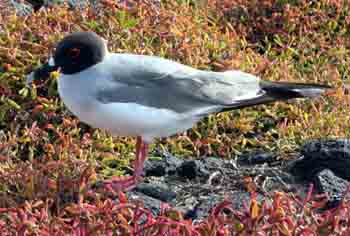 In the afternoon we hiked up along the cliffs of South Plaza Island encountering more seabirds. The island itself was striking, covered with a matting of foliage that was turning red and yellow in the warming sun as well as some simply huge cactuses. The foliage that produced this magnificent multicolored carpet also helped highlight the birds and animals beautifully as we reeled off more pictures for the scrapbook. On the ground we had great looks at many Land Iguanas and overhead we had Tropicbirds, Swallow-tailed Gulls and Nazca Boobies.
We also got our first chance to really get to see the Magnificent Frigatebirds in action. A common name for the birds is Man o’ War bird and they put on a great show of their pirating tendencies. With their inability to dive into the water, the frigates rely on kleptoparasitism (stealing to your layman) to rustle up a meal and the other islands inhabitants, both boobies and particularly Tropicbirds provide the perfect quarry. We watched in awe (and perhaps a little horror) as one frigatebird flew down after a tropicbird and literally grabbed it in mid air and shook it. The tropicbird complained mightily but the frigatebird would not let up its vice-like grip until the tropicbird gave up its meal. An amazing encounter and one that although a little unsettling was a privilege to see in action.
In the afternoon we hiked up along the cliffs of South Plaza Island encountering more seabirds. The island itself was striking, covered with a matting of foliage that was turning red and yellow in the warming sun as well as some simply huge cactuses. The foliage that produced this magnificent multicolored carpet also helped highlight the birds and animals beautifully as we reeled off more pictures for the scrapbook. On the ground we had great looks at many Land Iguanas and overhead we had Tropicbirds, Swallow-tailed Gulls and Nazca Boobies.
We also got our first chance to really get to see the Magnificent Frigatebirds in action. A common name for the birds is Man o’ War bird and they put on a great show of their pirating tendencies. With their inability to dive into the water, the frigates rely on kleptoparasitism (stealing to your layman) to rustle up a meal and the other islands inhabitants, both boobies and particularly Tropicbirds provide the perfect quarry. We watched in awe (and perhaps a little horror) as one frigatebird flew down after a tropicbird and literally grabbed it in mid air and shook it. The tropicbird complained mightily but the frigatebird would not let up its vice-like grip until the tropicbird gave up its meal. An amazing encounter and one that although a little unsettling was a privilege to see in action.
The highlight of the hike however wasn't the birds but our encounter with the Galapagos Sea Lion bachelor colony. Here the unattached males of the group spend their days lounging around, having the odd squabble and planning how to take charge of a group of females and run off one of the alpha males that guard them so closely. Their pad also hosts older alpha males that have reached 'retirement' or are taking a break, unable to muster up the battle hardiness that holding onto a harem of females requires. We could see some of those battle scars on display as well as the scars of shark attacks on the lions. One set of bones on the island highlighted the sort of damage that could be inflicted upon these graceful yet impressively hardy mammals by a shark looking for a meal (apparently even mortally wounded the lion had still mustered the strength to haul himself up onto these rather daunting rocky cliffs).
We left the seal boys to do their thing and headed back to the boat. As we arrived at our departure point we discovered that a group of Sea Lions were blocking our patch back to the boats but thanks to Santiago’s brave intervention they were soon dispersed, probably not a maneuver to be tried by those that haven't much experience with them. As an added bonus a passing booby or tropicbird decided to wish us all good luck by defecating heartily on us as we waited our zodiac ride. Boy that guano is strong stuff, no wonder plants love it so much!
Tues. July 8th – Rabida & Santiago Islands
This morning saw us visiting Rabida Island. Rabida is most famous for its stunning blood or brick red beach (depending on your taste in goriness), which was formed by the Scoria that forms the sand there (a high iron content volcanic rock). The islands striking red beach was beautifully offset by the teal coloration of the surrounding waters. We went on a short hike along the beach and foun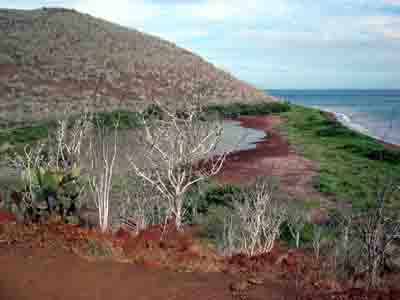 d a group of Brown Pelicans nesting along the shoreline amongst the Mangroves that dotted the steep slopes and also added another Wandering Tattler, American Oystercatcher and Ruddy Turnstone to our trip list. It was a little strange to encounter migrant birds that are so familiar to us on the shores of Connecticut so many thousands of miles away on a tropical island. I kept wondering whether unknowingly one day we might see these birds again but this time much closer to home.
d a group of Brown Pelicans nesting along the shoreline amongst the Mangroves that dotted the steep slopes and also added another Wandering Tattler, American Oystercatcher and Ruddy Turnstone to our trip list. It was a little strange to encounter migrant birds that are so familiar to us on the shores of Connecticut so many thousands of miles away on a tropical island. I kept wondering whether unknowingly one day we might see these birds again but this time much closer to home.
We then took a walk along the back side of the beach to have a look at a shallow lagoon. The lagoon itself was somewhat devoid of birds apart from a Cattle Egret which seemed to be ubiquitous on every island. What we lacked in birding excitement though was made up for by Santiago’s discovery of a Galapagos Hermit Crab. The crab took quite a shine to Santiago after he picked it up and we got a few great pictures of the crab clambering over his shirt.
After enjoying some more great snorkeling action the group headed back to the boat for lunch and the ride over to Santiago’s namesake island. On the way we enjoyed watching the very fitting Master and Commander with its Galapagos setting, a thoughtful addition to Mike and Pam’s luggage and a movie we all thoroughly enjoyed, although I did have to do my best to ignore that they had picked an Australian to play the lead in the film.
Santiago Island is renowned for its lava formations and black volcanic rocks which heat up rapidly during a sunny day, as those of us that decided to take the walk barefoot discovered. On the walk over to our destination, a small fur seal colony, we managed to locate another of the islands many endemic creatures. By overturning a couple of suitable looking rocks we were soon face to face with a number of Galapagos Scorpions. Not as frightening as it might sound, as these are tiny little scorpions no bigger than a nickel in most cases, but a treat to see nonetheless.
We arrived at the black beach at Puerto Egas where we soon found ourselves in the presence of some extremely laid back Galápagos Fur Seals. The sea lions (for that’s what they are rather than seals) had taken up prime spots in 'wells' formed in the lava rocks that let sea water rush in up the beach underneath them. Highlight of the wells was the amusingly titled ‘Darwin's Toilet’ which seemed to flush every time a wave crashed up upon the shore. The Fur Seals dozily posed for pictures whilst we spotted more fauna up and down the beach, this time species better acquainted to North Americans: Wandering Tattler, Whimbrel, Semipalmated Plover and American Oystercatcher. Some of these birds were breeding here and other had got just part of their way to the breeding grounds and given up for the year.
Amongst the birds the pools also attracted other animals including a wealth of Sally Lightfoot Crabs, Some Pacific Green Sea Turtles that had decided to use the pool as a crèche and a few very young baby Sea Lions that were using the pools as a fishing training ground. It was amusing to see these youngsters in pools not much larger than a big hot tub chasing around little schools of minute baitfish, obviously getting in practice and honing skills for a future in which they would have to head to sea and start to provide for themselves. These were probably the youngest of the Sea Lions that we saw, and at a couple of days old were the perfect subjects for another ream of photographs.
On the way back to the zodiacs we managed to find a rather tame Great-blue Heron doing a little hunting, but not as expected on a rocky shore or pool of water but rather searching for Lava Lizards in a grassy patch of field. He was much focused on the task at hand and pretty much ignored us whilst providing the group with more up close photo opportunities.
The evening saw us back to the boat for a special treat a BBQ dinner outside on the deck. It was real treat and everyone had a great evening with some monster shrimp and a couple of beers to wash them down with. Could anything be more perfect an outside meal with a group of wonderful people on a blissfully warm evening all within sight of a beautiful desert island, simply magical!
Wed. July 9th – Bartolomé & North Seymour Islands
And so we were on to our final full day on the Galapagos Islands. A bittersweet realization, but no time for mourning as the group was up pre-dawn for a climb up to the pinnacle of Bartolomé Island and a sunrise viewing of one of the Galapagos's most impressive vistas. This island is well known both for its stunning beauty, the view from the pinnacle rock as well as the opportunity to run into the world’s most northerly penguin, the Galapagos Penguin. Using the zodiac boats to get out to the island Santiago first steered the boats towards a known roosting spot for the Penguins and in the pre-dawn light the group managed to spot a penguin still napping before it headed off for a bit of morning fishing.
Sunrise had tended to be somewhat overcast while we were on the islands (with the clouds burning off by late morning) but this morning as if by special arrangement the sun popped out and lit up the surrounding Islands perfectly. There was just time to have breakfast and then we were back to Bartolomé for some more snorkeling, this time with the added incentive of the chance of snorkeling with some of the Galapagos Penguins.
No sooner had we pitched over the side of the boat than we were greeted by a penguin that almost appeared to come and welcome us to his cove. He then proceeded to perch up on the rocky coastline and provided us with close and spectacular views. The water was slightly cooler at Bartolomé but there was little time to think about it as more and more delights greeted us. A huge Ray skirted around the rocky shore and an even more impressive Pacific Green Sea Turtle amused us with its presence.
Santiago then spotted a small group of Penguins in the water just a few hundred yards away. We rapidly swum over to join them and they frolicked around us. Perhaps the most memorable moment of the trip for me was as they passed around and under me on their way to some better fishing grounds. At one point the penguins popped up right next to Annette almost within arms length and then began actively fishing just a few feet beneath us. Whilst fishing they turned from the somewhat comical looking creatures that we had seen perched on the rocks into perfectly formed fishing machines. They were the height of grace underwater, almost flying through it, twisting and turning constantly as they deftly maneuvered through the water - simply remarkable. Another special moment on a trip that was full of magical and memorable moments.
We took lunch on the boat whilst heading for North Seymour Island, our last unexplored island of the trip. This was the Galapagos that I had imagined in my mind before we arrived. Rather barren with dry looking stunted shrubby trees covering the landscape. In those trees however was another of the trips many delights, nesting frigatebirds.
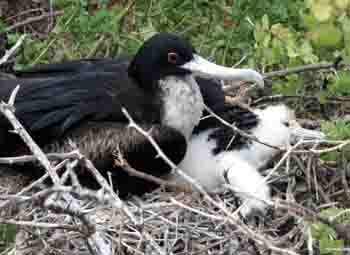 These pirates of the air were drawn to the island by its abundant breeding colonies of boobies and they nested in amongst them, feeding their young on the stolen scraps of fish that they could plunder from the surrounding birds. Hundreds of Greater and Magnificent Frigatebirds called this island home and our group was soon adept at picking out the differences between the two birds. Here we were close enough to see the differently colored eye-rings of the females and the different colored iridescent sheens that the male’s glossy black feathers produced. Here and there we also spotted juvenile birds and every now and then one of the white fuzz ball frigatebird chicks. It seemed that fish weren't the only things that frigatebirds were interested in stealing and we soon spotted quite a few battles over highly prized nest-building sticks. All around us the male frigatebirds were showing off their bright red gular pouches (a rather dangerous looking enterprise it seemed perched on the twiggy shrub perches). Again cameras whirred as we snapped more pictures of these thrilling birds. These sea birds are ones that you feel lucky to see soaring over a deserted sky in the middle of an ocean and here they were almost at our feet hustling and bustling in their closely knit breeding colonies.
These pirates of the air were drawn to the island by its abundant breeding colonies of boobies and they nested in amongst them, feeding their young on the stolen scraps of fish that they could plunder from the surrounding birds. Hundreds of Greater and Magnificent Frigatebirds called this island home and our group was soon adept at picking out the differences between the two birds. Here we were close enough to see the differently colored eye-rings of the females and the different colored iridescent sheens that the male’s glossy black feathers produced. Here and there we also spotted juvenile birds and every now and then one of the white fuzz ball frigatebird chicks. It seemed that fish weren't the only things that frigatebirds were interested in stealing and we soon spotted quite a few battles over highly prized nest-building sticks. All around us the male frigatebirds were showing off their bright red gular pouches (a rather dangerous looking enterprise it seemed perched on the twiggy shrub perches). Again cameras whirred as we snapped more pictures of these thrilling birds. These sea birds are ones that you feel lucky to see soaring over a deserted sky in the middle of an ocean and here they were almost at our feet hustling and bustling in their closely knit breeding colonies.
Another avian highlight of the island was the birds that had drawn the frigatebirds here, the numbers of nesting Blue-footed Boobies. The male Boobies would whistle (forlornly it seemed to me) at every passing female in the hopes of drawing in the attention of a possible mate. As we turned one corner we were treated to their strange mating ritual in full, a whistling male booby caught a passing females attention as she flew by and she dropped in to check him out (almost knocking over a couple of the group). Anyway, much suggestive waddling and wing and tail lifting later he seemed to seal the deal as she joined him in some waddling around the prospective nest site (a small cleared depression in the earth). Amongst the birds we also discovered more Land Iguanas and again we were treading carefully so as not to step on any of the Lava Lizards, which were so common on most islands it was hard to put a foot down without the fear that you might squish one.
And so to our last night on the islands, a few people enjoyed a glass of wine or two with their meal and after a farewell toast of the crew it was on to what has now become a ritual of Sunrise Birding trips to the Galapagos: 'Impressions Night'. On previous trips people had decided that on the last night participants would act out their favorite animals of the tour. David started the ball rolling with an excellently portrayed Magnificent Frigatebird along with mating display to the embarrassed amusement of Stephanie. The evening quickly spiraled onwards from there and soon everyone on the boat was having a rare old time coming up with inventive and amusing representations of their favorite creatures: Gerry and myself acted out the Albatross mating dance, David amused us with his ‘Dance of the Blue-footed Booby’, the kids acted out their impression of Marine Iguanas, which all seemed to be an excuse for everyone to pile on top of each other. Paul of course, as official trip photographer, was doing his best to get all of this captured for posterity and even managed to get most of the acts captured on video (which will come in handy for bribing various family members at some point in the future I am sure). There were many highlights: The puffer fish by Paul and a host of inventive impressions that Meaghan rolled off one after the other. The grand finale was our trusty barman Ivan’s impression of a White-tipped Reef Shark that he left us with before departing to the shore for some well earned vacation.
Thurs. July 10th – San Cristóbal Island
The last day we plumped to visit the island information center/museum which documented both the formation of the island and the often saddening relationship that man has had with them. A nice summation of all that we had seen on the island and with plenty of further interesting tidbits of information which Santiago our guide helped to expand upon. We had time for just a few last minutes of shopping before heading back to get the bus over to the airport. We said our final goodbyes to these wonderful islands as well as to David and Stephanie, who were hanging on for a few more days of adventure scuba diving in search of sharks!
We arrived back in Quito in time for a last meal together as a group. Juan’s mother in-law rustled up her famous avocado soup (fresh from the yard!!!), a requested reprise from earlier in the trip. We all further contemplated the idea of publishing a book of Ecuadorian soups as we said fond farewells to each other and thanked Juan for his help in making the show run quite as smoothly as it had. A bittersweet evening as we were all saying goodnight to people who had become good friends over the last couple of weeks, knowing that by breakfast the next morning most of us would be on their way home.
The next day the group split apart with some flying home on early flights home, others off for a trip around Old Town Quito for a couple of hours pre-airport and myself off for some extreme birding in the Andes.
All in all it was a fantastic trip with consistently great food and comfortable accommodations. Equally importantly it was a great group of travelers who were both fun and interesting to share two weeks with. Ecuador and the Galapagos were both stunning visually and filled with exciting places to see and explore. The friendly and helpful people of both the islands and the mainland contributed to make this a wonderful trip to a breathtaking country and like many of the participant’s one which I would like to return to again in the not too distant future. Thanks to everyone involved for making this such an enjoyable trip.
